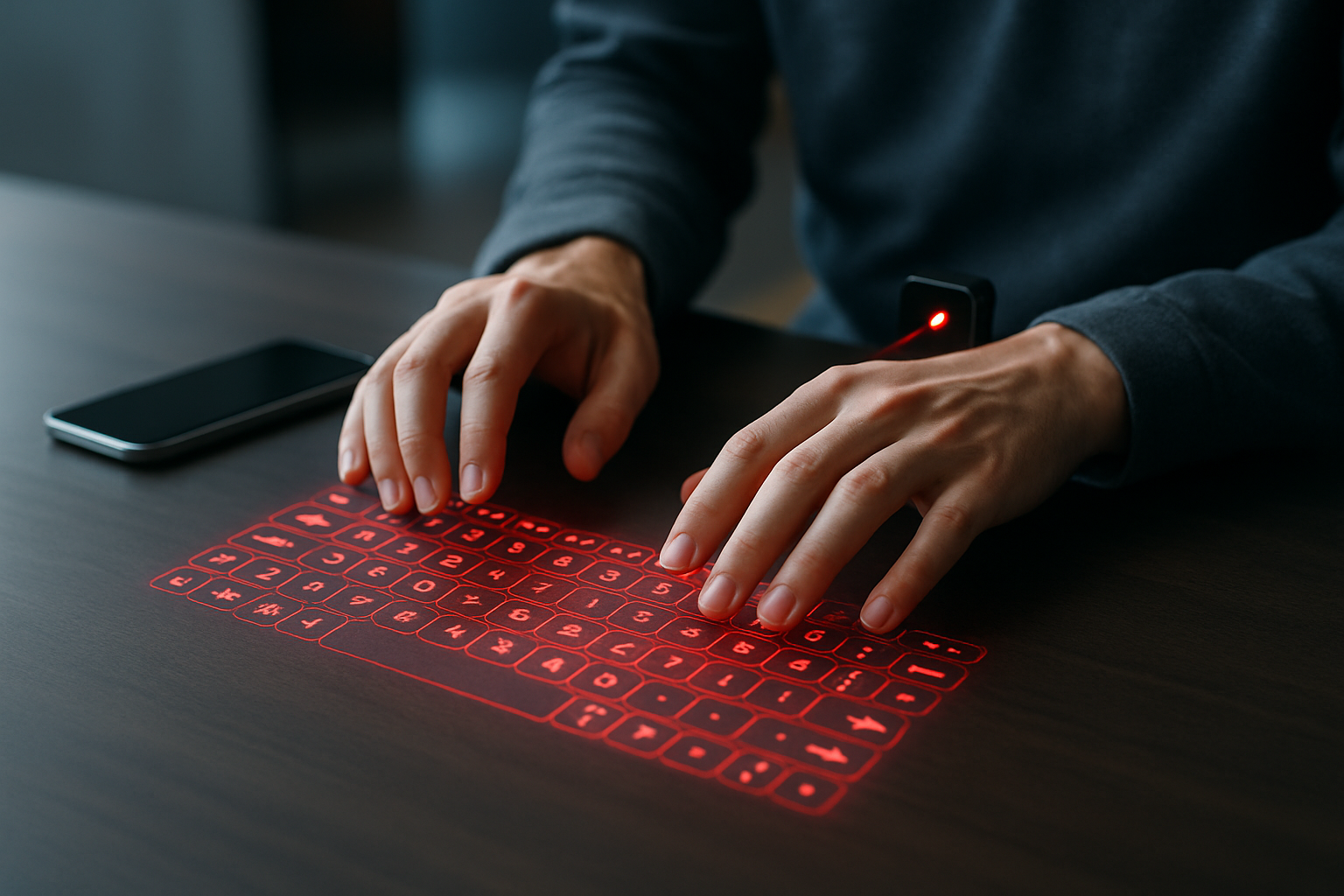Holographic Keyboards: Typing in Thin Air
In a world where technology continues to push boundaries, holographic keyboards are emerging as a futuristic input method that could revolutionize how we interact with our devices. These ethereal interfaces project a virtual keyboard onto any flat surface, allowing users to type without physical keys. As we delve into this cutting-edge technology, we'll explore its potential to transform computing, mobile devices, and even augmented reality experiences.

The Science Behind the Magic
Holographic keyboards rely on a clever combination of optics and sensor technology. At their core, these devices use a laser projector to cast an image of a keyboard onto a surface. This isn’t just any projection, though – it’s a precisely calibrated image that creates the illusion of a three-dimensional keyboard floating in space.
The real magic happens when you start to type. Infrared sensors create an invisible plane just above the projected keyboard. When your fingers break this plane, the sensors detect the position and movement, translating it into keystrokes. Some advanced systems even use cameras to track finger positions in three dimensions, allowing for more accurate input and even the potential for gesture controls.
A Brief History of Virtual Typing
The concept of virtual keyboards isn’t entirely new. Early attempts at creating projection-based input devices date back to the early 2000s. However, these early prototypes were bulky, inaccurate, and far from practical for everyday use.
As laser technology improved and sensors became more sophisticated, holographic keyboards began to evolve. By the 2010s, several companies had introduced compact projectors capable of creating virtual keyboards for smartphones and tablets. While these early consumer products were more novelty than practical tool, they laid the groundwork for the more advanced systems we’re seeing today.
The Advantages of Typing on Light
Holographic keyboards offer several potential advantages over their physical counterparts. Perhaps the most obvious is their portability. When not in use, these devices can be as small as a keychain, making them ideal for mobile professionals or anyone looking to minimize the bulk in their tech setup.
Another significant benefit is customization. Since the keyboard is projected, it can be easily reconfigured for different languages, layouts, or even specialized functions. Imagine switching from a standard QWERTY layout to a complex video editing control panel with just a few taps.
Holographic keyboards also promise improved hygiene. With no physical keys to harbor germs, these devices could be particularly appealing in shared environments or public spaces. Additionally, the lack of moving parts means there’s less potential for mechanical failure or wear and tear over time.
Challenges and Limitations
Despite their futuristic appeal, holographic keyboards still face several challenges before they can become mainstream. One of the most significant hurdles is the lack of tactile feedback. Physical keyboards provide a satisfying click and resistance that many typists rely on for accuracy and speed. Replicating this sensation in a projection-based system is a complex problem that researchers are still working to solve.
Environmental factors also play a role in the effectiveness of holographic keyboards. Bright light can interfere with the projection, making the keyboard difficult to see. Uneven or textured surfaces can distort the image and affect input accuracy. These limitations mean that, for now, holographic keyboards are best suited for controlled environments rather than on-the-go use.
The Future of Holographic Input
As technology continues to advance, we can expect to see significant improvements in holographic keyboard systems. Researchers are exploring ways to provide haptic feedback, potentially using ultrasound waves to create the sensation of pressing physical keys. This could dramatically improve the typing experience and make holographic keyboards more viable for extended use.
The integration of holographic keyboards with augmented reality (AR) systems is another exciting frontier. Imagine wearing AR glasses that not only project a virtual keyboard but also display your typing in mid-air. This could lead to new forms of mobile computing and collaboration, freeing us from the constraints of physical screens and input devices.
Market Impact and Pricing
While holographic keyboards are still largely in the realm of early adopters and tech enthusiasts, they’re beginning to make inroads into the consumer market. Current standalone holographic keyboard devices range in price from around $100 to $300, depending on features and capabilities. As the technology matures and production scales up, we can expect these prices to drop, potentially making holographic keyboards competitive with high-end physical keyboards.
The potential market impact of this technology extends beyond just replacing traditional keyboards. Holographic input systems could find applications in areas like automotive interfaces, industrial controls, and even medical environments where sterile, customizable input methods are valuable.
As we look to the future, holographic keyboards represent more than just a novel way to type. They’re a glimpse into a world where our interactions with technology become increasingly fluid and untethered from physical constraints. While there are still challenges to overcome, the potential of this technology to reshape how we work, communicate, and create is truly exciting. As development continues, we may find ourselves on the cusp of a new era in human-computer interaction, where the boundaries between the physical and digital worlds continue to blur.





